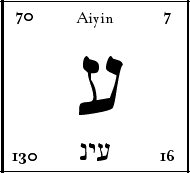A • B • C • D • E •
F • G • H • I • J • K • L •
M
N • O • P • Q • R •
S • T • U • V • W • X • Y •
Z
Hebrew:
Aleph • Beit • Geemel • Dalet •
Hay • Vahv • Zaiyin • Chait • Tait
Yoad • Kaf • Lahmed • Mame • Nune •
Sahmek • Aiyin • Pay
Tzahday • Qoaf •
Raysh • S(h)een • Tahv

Aiyin
Spelling: aiyin yoad nune
The common pronunciation of the name of the letter aiyin is very
similar to the English phrase ‘eye
in’. It’s sound is almost a stop, a sort of ‘rgh’ noise in
the back of the throat. Its spelling is Hebrew for eye or spring
(as in a well — a
source of water). It thus acquires connotations of drawing experience
inward, and of pouring forth sustenance. Aiyin is the existential
projection of zaiyin — and we can see how it represents both ‘the
scepter’ or the quality of seeing from above — and
also the way in which seeing ‘divides’ entities, one
from another — akin to
the activity of a sword.
The shape of the letter is that of a rightward elongated nune,
with a zaiyin or vahv attached on the left. As a vahv, this indicates
the penetration of the divine dimension in the sense of seeing,
both in terms of insight and vision. As a zaiyin we could speculate
that the feminine witness lends her heart (emotional wisdom) to
the penetrating character of seeing, or that seeing is the crowned
sense — the ‘most high’ of all extrinsic senses — for
it receives light, movement and color all at once. There are other
interpretations
of the shape, such as ‘two eyes’ connected to the mouth — we
speak of what we see, both internally as understanding and externally
in the existential universe.
One thing we should understand about having two eyes is that it
results in four: the left eye, the right eye — their sum —
and an inner eye. Our extrinsic seeing is at least triune, and
this experience is the progenitor of our inward sense of seeing
— insight, or understanding. Each eye sees a unique presentation
of the world, and together this forms a unified symmetry, which
is far more than the sum of its parts. Inwardly, our ‘seeing’ is
similar — it is the activity of the whole organism in union
with its sources and infinite dimensions of relation. Seeing is
an experience
of hypersystems— living and energetic. In all of space and
time perhaps the rarest physical gift is that of having color vision.
Eyes are living evidence of God: their amazing complexity and profound
qualities of communication and sensing are unsurpassed, and perhaps
unsurpassable. Earth is an extremely delicate ‘tree’ filled
with millions of forms of eyes, all connected as one, and all connecting
to The One Who Is.
It is this unique inward/outward integration which ‘comes
after’
sahmek, illustrating the relationship between circles, cycles,
spirals, and seeing. Sahmek, a ‘picture of a world’,
in receiving the energetic emanations of Sol, the local star, bears ‘eye
children’,
who see the forms and characters of things and beings ‘in
light’
and within, as ‘insight’ — or, ‘an eye
in(side)’. The ‘water-eye’ children.
o:O:o
o:O:o
Family: Existential: Actualized in existence within
the spiral/cone of transentient emanation. Existing within space-time.
The second 9 letters.
Archetypal: Zaiyin
Existential: Aiyin
Supernal: (Nune-sophit)
Position: The sixteenth letter. The tenth of the ‘twelve
elementals’ or simples.
Common associations:
Primary Significations: Insight.
Secondary Significations: Oversight. Government.
Body: The liver.
Power:
Activity:
Sign: Capricorn
Archetype / Tribe: Dan
Element:
Path on the Tree of Life:
Traditional: Binah / Tiphareth
Hermetic: Tiphareth / Netzach
A • B • C • D • E • F • G • H • I • J • K • L • M
N • O • P • Q • R • S • T • U • V • W • X • Y • Z
Hebrew:
Aleph • Beit • Geemel • Dalet • Hay • Vahv • Zaiyin • Chait • Tait
Yoad • Kaf • Lahmed • Mame • Nune • Sahmek • Aiyin • Pay
Tzahday • Qoaf • Raysh • S(h)een • Tahv